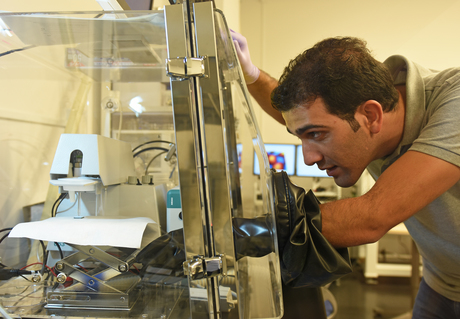Why does ambient air improve perovskite solar cells?

By exposing perovskite solar cells — the cheaper, lighter and more flexible alternative to crystalline silicon-based cells — to ambient air for several hours after fabrication, their efficiency and effectiveness improves. The strange thing is that, until recently, no-one knew exactly why.
Researchers from the Okinawa Institute of Science and Technology Graduate University (OIST), led by Professor Yabing Qi, sought to explain the science behind what has fast become a common practice. The results of their study have been published in the journal Advanced Materials Interfaces.
“It’s intriguing: why do we need ambient air to enhance the effectiveness of perovskite solar cells?” said Zafer Hawash, first author on the study. “Which component of the ambient air is linked to this phenomenon?”
The researchers began their study by focusing on the top layer of the solar cells — the layer in direct contact with ambient air. This is called ‘hole transport layer’ and has a dopant, which is a substance that enhances the electrical conductivity of the material.
“It is known that the dopant of the hole transport layer plays a key role in perovskite solar cells’ performance,” Hawash said. “But it was not clear how.”
The scientists exposed the hole transport layer to environmental gases, focusing on oxygen, nitrogen and moisture — water that is in a gas state. Then, they checked the electrical properties of the hole transport layer to see if and how it had changed on the inside.
“What we found is that oxygen and nitrogen do not have any role in the redistribution of the dopants,” said Hawash. “But in the case of moisture, the solar cells’ efficiency increases. This is the discovery: moisture is the air component that causes the redistribution of the dopant across the material and, thus, the enhancement of the electric properties of the solar cells.”
The reason for this, the scientists explained, is that the transport layer has many pinholes that allow the passage of gases between the ambient and the underneath material. The dopant in the transport layer is a salt — Lithium TFSI — which absorbs water. When the solar cells are exposed to moisture, the water absorbed by the transport layer causes the dopant to redistribute.
Counterintuitively, then, water is what you need to have a perovskite solar cell that works properly — though the researchers warn that long-time exposure to moisture has a detrimental effect on the solar cells.
“Oxygen enhances the electrical conductivity of the transport layer as well, but this effect does not last long,” Hawash noted. “But with the right amount of exposure to moisture, the electric proprieties are irreversibly enhanced.”
Sodium-ion battery breakthrough boosts energy storage
Scientists have discovered that leaving water inside a key material, rather than removing it,...
Setting a new standard for solar efficiency testing
Researchers from Simon Fraser University have proposed a new framework to standardise testing of...
Magnesium battery prototype operates at room temperature
Researchers have developed a prototype rechargeable magnesium battery that demonstrates stable,...








